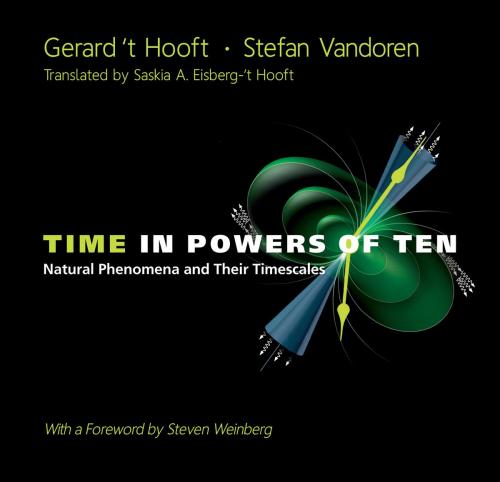Time in Powers of Ten
Natural Phenomena and Their Timescales
Nonfiction, Science & Nature, Science, Physics, General Physics| Author: | Gerard 't Hooft, Stefan Vandoren, Saskia Eisberg- 't Hooft | ISBN: | 9789814494939 |
| Publisher: | World Scientific Publishing Company | Publication: | May 12, 2014 |
| Imprint: | WSPC | Language: | English |
| Author: | Gerard 't Hooft, Stefan Vandoren, Saskia Eisberg- 't Hooft |
| ISBN: | 9789814494939 |
| Publisher: | World Scientific Publishing Company |
| Publication: | May 12, 2014 |
| Imprint: | WSPC |
| Language: | English |
With a Foreword by Steven Weinberg
In this richly illustrated book, Nobel Laureate Gerard 't Hooft and Theoretical Physicist Stefan Vandoren describe the enormous diversity of natural phenomena that take place at different time scales.
In the tradition of the bestseller Powers of Ten, the authors zoom in and out in time, each step with a factor of ten. Starting from one second, time scales are enlarged until processes are reached that take much longer than the age of the universe. After the largest possible eternities, the reader is treated to the shortest and fastest phenomena known. Then the authors increase with powers of ten, until again the second is reached at the end of the book.
At each time scale, interesting natural phenomena occur, spread over all scientific disciplines: orbital and rotation periods of planets and stars, decay times of elementary particles and atoms, biological rhythms and evolution processes, but also the different geological time scales.
Contents:
-
Part I:
- 100 Seconds = 1 Second
- 101 Seconds = 10 Seconds
- 102 Seconds = 100 Seconds = 1 Minute, 40 Seconds
- 103 Seconds = 1,000 Seconds = 16 Minutes, 40 Seconds
- 104 Seconds = 10,000 Seconds = 2.78 Hours
- 105 Seconds = 100,000 Seconds = 1.16 Days = 27.78 Hours
- 106 Seconds = 1,000,000 = 1 Million Seconds = 11.57 Days = 1.65 Weeks
- 106.41 Seconds = 2,592,000 Seconds = 30 Days ≈ 1 Month
- 107 Seconds = 10 Million Seconds = 115.74 Days = 3.86 Months
- 108 Seconds = 100 Million Seconds = 3.17 Years
- 109 Seconds = 1 Billion Seconds = 31.7 Years
- 1010 Seconds = 10 Billion Seconds = 317 Years
- 1011 Seconds = 100 Billion Seconds = 3,171 Years
- 1012 Seconds = 1 Trillion Seconds = 31,710 Years
- 1013 Seconds = 10 Trillion Seconds = 317,098 Years
- 1014 Seconds = 100 Trillion Seconds = 3.17 Million Years
- 1015 Seconds = 1 Quadrillion Seconds = 31.7 Million Years
- 1016 Seconds = 10 Quadrillion Seconds = 317 Million Years
- 1017 Seconds = 100 Quadrillion Seconds = 3.17 Billion Years
- 1018 Seconds = 1 Quintillion Seconds = 31.7 Billion years: The Large Timescales
- 1021 seconds = 1 Sextillion Seconds = 3.17 × 1013 Years: The Large Timescales
- 1028 Seconds = 3.17 × 1020 Years: The Large Timescales
- 1032 Seconds: To Infinity and Beyond: The Dark Eternities
-
Part II:
- 10-44 to 10-26 Seconds: Small Timescales
- 10-25 Seconds
- 10-24 Seconds = 1 Yoctosecond
- 10-23 Seconds = 10 Yoctoseconds
- 10-22 Seconds = 100 Yoctoseconds
- 10-21 Seconds = 1 Zeptosecond
- 10-20 Seconds = 10 Zeptoseconds
- 10-19 Seconds = 100 Zeptoseconds
- 10-18 Seconds = 1 Attosecond
- 10-17 Seconds = 10 Attoseconds
- 10-16 Seconds = 100 Attoseconds
- 10-15 Seconds = 1 Femtosecond
- 10-14 Seconds = 10 Femtoseconds
- 10-13 Seconds = 100 Femtoseconds
- 10-12 Seconds = 1 Picosecond
- 10-11 Seconds = 10 Picoseconds
- 10-10 Seconds = 100 Picoseconds
- 10-9 Seconds = 1 Nanosecond
- 10-8 Seconds = 10 Nanoseconds
- 10-7 Seconds = 100 Nanoseconds
- 10-6 Seconds = 1 Microsecond
- 10-5 Seconds = 10 Microseconds
- 10-4 Seconds = 100 Microseconds = 0.0001 Seconds
- 10-3 Seconds = 1 Millisecond = 0.001 Seconds
- 10-2 Seconds = 10 Milliseconds = 0.01 Seconds
- 10-1 Seconds = 100 Milliseconds = 0.1 Seconds
- 100 Seconds = 1 Second
-->Readership: Science enthusiasts and students.
With a Foreword by Steven Weinberg
In this richly illustrated book, Nobel Laureate Gerard 't Hooft and Theoretical Physicist Stefan Vandoren describe the enormous diversity of natural phenomena that take place at different time scales.
In the tradition of the bestseller Powers of Ten, the authors zoom in and out in time, each step with a factor of ten. Starting from one second, time scales are enlarged until processes are reached that take much longer than the age of the universe. After the largest possible eternities, the reader is treated to the shortest and fastest phenomena known. Then the authors increase with powers of ten, until again the second is reached at the end of the book.
At each time scale, interesting natural phenomena occur, spread over all scientific disciplines: orbital and rotation periods of planets and stars, decay times of elementary particles and atoms, biological rhythms and evolution processes, but also the different geological time scales.
Contents:
-
Part I:
- 100 Seconds = 1 Second
- 101 Seconds = 10 Seconds
- 102 Seconds = 100 Seconds = 1 Minute, 40 Seconds
- 103 Seconds = 1,000 Seconds = 16 Minutes, 40 Seconds
- 104 Seconds = 10,000 Seconds = 2.78 Hours
- 105 Seconds = 100,000 Seconds = 1.16 Days = 27.78 Hours
- 106 Seconds = 1,000,000 = 1 Million Seconds = 11.57 Days = 1.65 Weeks
- 106.41 Seconds = 2,592,000 Seconds = 30 Days ≈ 1 Month
- 107 Seconds = 10 Million Seconds = 115.74 Days = 3.86 Months
- 108 Seconds = 100 Million Seconds = 3.17 Years
- 109 Seconds = 1 Billion Seconds = 31.7 Years
- 1010 Seconds = 10 Billion Seconds = 317 Years
- 1011 Seconds = 100 Billion Seconds = 3,171 Years
- 1012 Seconds = 1 Trillion Seconds = 31,710 Years
- 1013 Seconds = 10 Trillion Seconds = 317,098 Years
- 1014 Seconds = 100 Trillion Seconds = 3.17 Million Years
- 1015 Seconds = 1 Quadrillion Seconds = 31.7 Million Years
- 1016 Seconds = 10 Quadrillion Seconds = 317 Million Years
- 1017 Seconds = 100 Quadrillion Seconds = 3.17 Billion Years
- 1018 Seconds = 1 Quintillion Seconds = 31.7 Billion years: The Large Timescales
- 1021 seconds = 1 Sextillion Seconds = 3.17 × 1013 Years: The Large Timescales
- 1028 Seconds = 3.17 × 1020 Years: The Large Timescales
- 1032 Seconds: To Infinity and Beyond: The Dark Eternities
-
Part II:
- 10-44 to 10-26 Seconds: Small Timescales
- 10-25 Seconds
- 10-24 Seconds = 1 Yoctosecond
- 10-23 Seconds = 10 Yoctoseconds
- 10-22 Seconds = 100 Yoctoseconds
- 10-21 Seconds = 1 Zeptosecond
- 10-20 Seconds = 10 Zeptoseconds
- 10-19 Seconds = 100 Zeptoseconds
- 10-18 Seconds = 1 Attosecond
- 10-17 Seconds = 10 Attoseconds
- 10-16 Seconds = 100 Attoseconds
- 10-15 Seconds = 1 Femtosecond
- 10-14 Seconds = 10 Femtoseconds
- 10-13 Seconds = 100 Femtoseconds
- 10-12 Seconds = 1 Picosecond
- 10-11 Seconds = 10 Picoseconds
- 10-10 Seconds = 100 Picoseconds
- 10-9 Seconds = 1 Nanosecond
- 10-8 Seconds = 10 Nanoseconds
- 10-7 Seconds = 100 Nanoseconds
- 10-6 Seconds = 1 Microsecond
- 10-5 Seconds = 10 Microseconds
- 10-4 Seconds = 100 Microseconds = 0.0001 Seconds
- 10-3 Seconds = 1 Millisecond = 0.001 Seconds
- 10-2 Seconds = 10 Milliseconds = 0.01 Seconds
- 10-1 Seconds = 100 Milliseconds = 0.1 Seconds
- 100 Seconds = 1 Second
-->Readership: Science enthusiasts and students.















